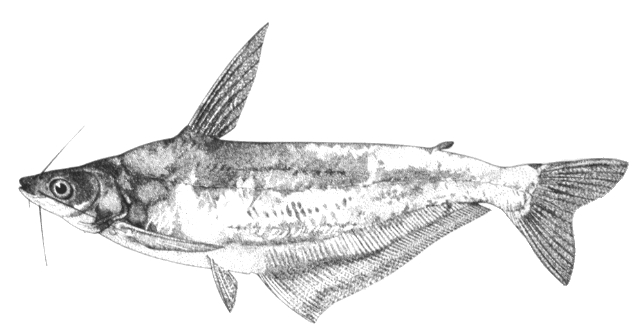| Schilbeidae (Schilbid catfishes) |
| 25.2 cm SL (male/unsexed) |
|
demersal; freshwater, |
| Africa: middle Congo River basin in Democratic Republic of the Congo, including Pool Malebo (= Stanley Pool); especially common in Lake Tumba (Ref. 43912). |
|
Dorsal spines (total): 1-1. Diagnosis: adipose fin always present; anterior nostrils closer to each other than posterior ones; snout reaching slightly beyond lower jaw; nasal barbel always reaching beyond orbit; eyes rather large (horizontal diameter 26,8-33,1% HL); inner side of pectoral spine feebly serrated (Ref. 43912).
Description: 8-10 branched pectoral fin rays; 38-53 branched anal fin rays; 43-47 non-fused vertebrae; 8-10 branchiostegal rays on one side of head; caudal peduncle longer than deep; nasal barbel at least reaches to posterior border of eye and at maximum to posterior border of opercle; maxillary barbel reaches at least to posterior border of opercle and at maximum to midway of pectoral spine; inner mandibular barbels short and never reach beyond center of eye; outer mandibular barbels at least reaching to posterior border of eye and at maximum to posterior opercle border; dorsal and/or pectoral spines sometimes provided with a filamentous prolongation; some specimens totally or partially lack pelvic fins (Ref. 43912). Schilbe tumbanus shows some affinities with the sympatric species S. grenfelli which also has the anterior nostrils closer to each other than the posterior ones, but S. tumbanus is easily distinguished from this species by the longer nasal barbel always reaching beyond the orbit, while never reaching beyond the posterior border of the eye in S. grenfelli (Ref. 43912).
Coloration: preserved specimens: head and back brown-black; flanks somewhat paler, sometimes more or less irregularly stained; belly ventrally whitish, laterally speckled; all fins more or less greyish speckled (Ref. 43912). In life: grey-bluish, with pale blue-green metallic reflections; back and head darker, paler ventrally; unclear, dark post-opercular spot; eye greyish golden with green reflection; fins greyish, more or less dark, especially dorsal, caudal and pectoral fins (based on Matthes 1964; Ref. 43912). |
| Confined to larger lakes and rivers; possibly a shoaling species; polyphagous with a frugivorous tendency; stomach contents examined showed the presence of sand, mud, benthic vegetable remains, leaves, fruits and insect remains (Ref. 43912). Oviparous, eggs are unguarded (Ref. 205). Probably of economic importance locally for fishermen of Lake Tumba; maximum reported TL 280mm (Ref. 43912). |
|
Least Concern (LC); Date assessed: 16 February 2009 Ref. (130435)
|
| harmless |
Source and more info: www.fishbase.org. For personal, classroom, and other internal use only. Not for publication.

